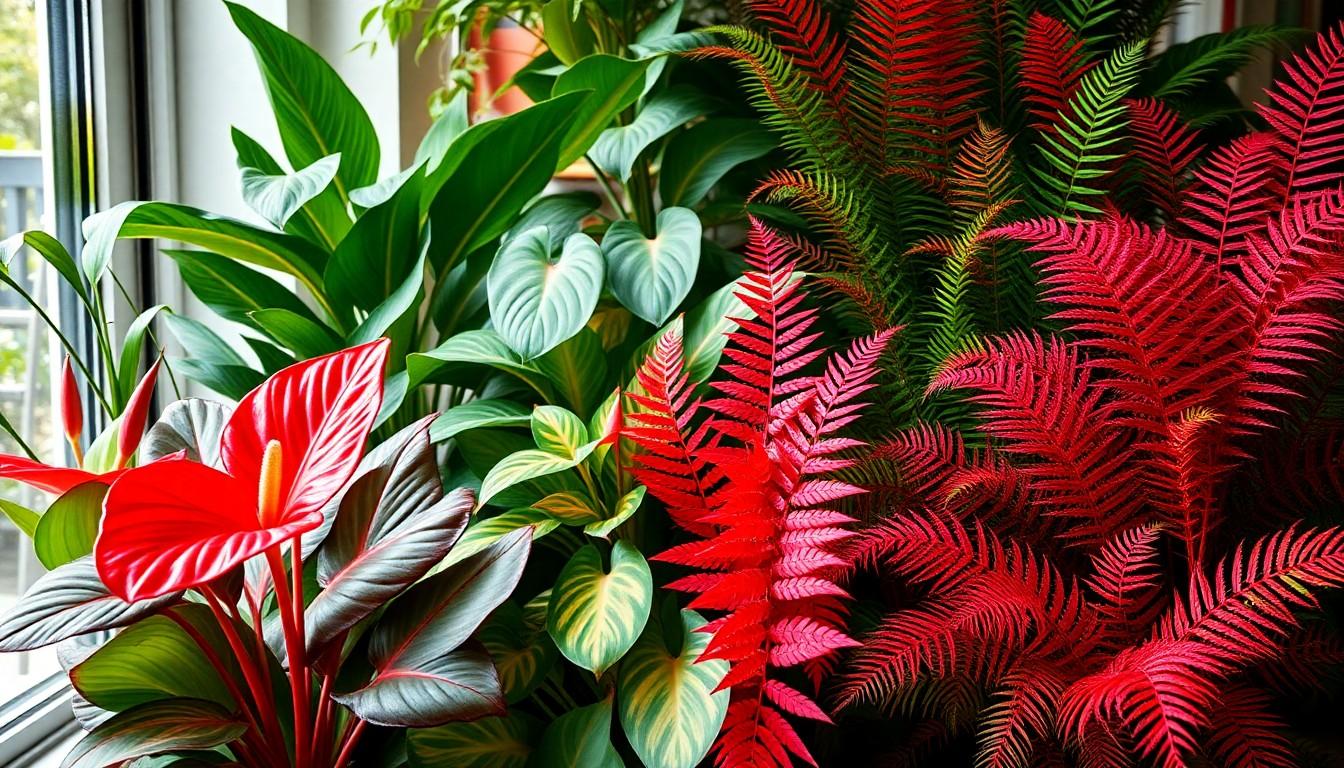When it comes to sprucing up a living space, nothing quite captures attention like a splash of red. Red house plants not only brighten up a room but also add a bold statement that says, “I know how to live life on the edge.” From fiery foliage to vibrant blooms, these plants are the perfect conversation starters for your next gathering—or the ideal companions for a Netflix binge.
Imagine walking into a room filled with lush green plants, only to be greeted by a striking red beauty. It’s like a superhero in a sea of sidekicks. With their ability to thrive indoors and their eye-catching hues, red house plants can transform any dull corner into a lively oasis. So why settle for ordinary when you can embrace the extraordinary? Let’s dive into the world of these vibrant plants and discover why they deserve a spot in every home.
Overview Of Red House Plants
Red house plants add striking allure to indoor spaces. Varieties such as the Red Aglaonema, with its vibrant leaves, stand out in any room. Many owners cherish their red foliage for both aesthetic and air-purifying qualities, making them beneficial additions to homes.
These plants often thrive in indirect sunlight, adapting well to various indoor conditions. For example, the Burgundy Rubber Plant showcases rich red tones, enhancing contemporary decor. Additionally, the Anthurium, known for its glossy red blooms, provides enchanting contrast to darker surroundings.
Care requirements for red house plants vary but generally include well-draining soil and moderate watering. Inconsistent moisture can lead to root rot, so maintaining a regular watering schedule proves crucial. Fertilizing during the growing season promotes healthy growth, encouraging vibrant foliage and flowering.
Some red plants, such as the Red Velvet Plant, are particularly sought after by collectors. Their unique patterns create a stunning visual impact, adding diversity to any plant collection. Choosing red house plants not only beautifies an environment but also fosters a connection to nature.
While many red plants are non-toxic, others may pose risks to pets. Awareness of plant toxicity stands essential for pet owners considering new greenery. By selecting the right species, it’s possible to enjoy the decorative benefits of red plants while ensuring a safe home environment.
Popular Types Of Red House Plants

Red house plants add vibrancy to any room. Some popular varieties stand out due to their unique appearance and care requirements.
Anthurium
Anthurium is known for its waxy red spathes and glossy dark green foliage. This tropical plant thrives in bright, indirect sunlight and tolerates low-light conditions. Watering occurs every 1-2 weeks, allowing the top inch of soil to dry between watering sessions. It only requires fertilization every 6-8 weeks during the growing season. Anthurium is also appreciated for its air-purifying qualities, making it an excellent choice for improving indoor air quality.
Red Aglaonema
Red Aglaonema features stunning red and green leaves, making it a visual highlight in any space. It flourishes in low to moderate light, making it ideal for various room conditions. Watering should occur when the top inch of soil is dry, typically every week or so. This resilient plant tolerates neglect, making it particularly appealing for busy plant enthusiasts. Additionally, Red Aglaonema’s air-purifying abilities contribute to a healthier indoor environment.
Red Ferns
Red ferns display beautiful fronds that exhibit reddish hues, adding depth to home decor. These ferns prefer indirect light and consistent humidity levels to thrive. Water them when the top layer of soil feels dry, ensuring not to overwater. Mist the leaves occasionally to maintain humidity, especially in dry climates. Red ferns revive indoor spaces while also providing air-cleansing benefits, improving overall well-being.
Care Tips For Red House Plants
Caring for red house plants involves specific attention to watering, light, and soil preferences. Understanding these needs ensures vibrant growth and longevity.
Watering Requirements
Watering red house plants requires attentiveness. Soil moisture should remain consistent, with many varieties thriving when the top inch of soil dries out between waterings. Overwatering can lead to root rot, impacting plant health. A general rule involves watering more frequently during the growing season and reducing this during dormancy. Additionally, observing the plant’s response can provide key insights; yellowing leaves often signal excess moisture, while crisp, brown tips indicate insufficient water.
Light Conditions
Light conditions play a vital role in the growth of red house plants. Most varieties thrive in bright, indirect sunlight, which enhances their vibrant color without causing leaf burn. Some, like the Red Aglaonema, can tolerate low light, making them suitable for shadier spots. It’s essential to rotate plants regularly to ensure even light distribution. If leaves appear pale or leggy, the plant may need more exposure to light.
Soil Preferences
Soil preferences dictate success with red house plants. Well-draining soil is crucial to prevent excess moisture buildup. A versatile potting mix combined with perlite or sand can enhance drainage, addressing the needs of various species. Regularly checking that the soil remains aerated helps roots access necessary nutrients effectively. Additionally, repotting every couple of years allows for fresh soil, promoting healthier growth.
Benefits Of Having Red House Plants
Red house plants offer several advantages that enhance indoor environments. They improve air quality by filtering toxins, making spaces healthier for occupants. Plants like the Burgundy Rubber Plant and Red Aglaonema excel at this, contributing clean air while adding vivid colors.
Aesthetic appeal plays a significant role in home decor. The striking hues of red plants serve as focal points, drawing attention and sparking conversation among guests. They complement various design styles, from modern to bohemian, thereby enhancing overall ambiance.
Incorporating red house plants supports mental well-being. Studies show that greenery reduces stress levels and boosts mood. Having vibrant plants nearby creates a calming atmosphere, ideal for relaxation after a long day.
Some varieties possess additional health benefits. For instance, Anthurium is known for its air-purifying properties, removing harmful pollutants. Studies confirm that indoor plants can lead to better concentration and productivity, making them ideal companions for workspaces.
Cultivating red house plants nurtures a sense of responsibility and connection to nature. Caring for these plants instills a routine, promoting mindfulness and reducing anxiety. Engaging with greenery fosters a positive environment.
Lastly, red house plants offer unique varieties that appeal to collectors. Species like the Red Velvet Plant add diversity, making plant ownership an exciting hobby. Their rarity and aesthetic value often lead to increased appreciation among plant enthusiasts.
Conclusion
Red house plants offer a vibrant way to enhance any living space. Their striking colors and unique shapes make them perfect focal points that can transform a room’s ambiance. By choosing the right varieties and providing proper care, anyone can enjoy the beauty and benefits these plants bring.
From improving air quality to boosting mood, red house plants are more than just decorative elements. They create a sense of connection to nature while adding a touch of excitement to plant ownership. With a little attention to their needs, these extraordinary plants can thrive and bring joy for years to come. Embracing red house plants not only elevates home decor but also enriches one’s life.

